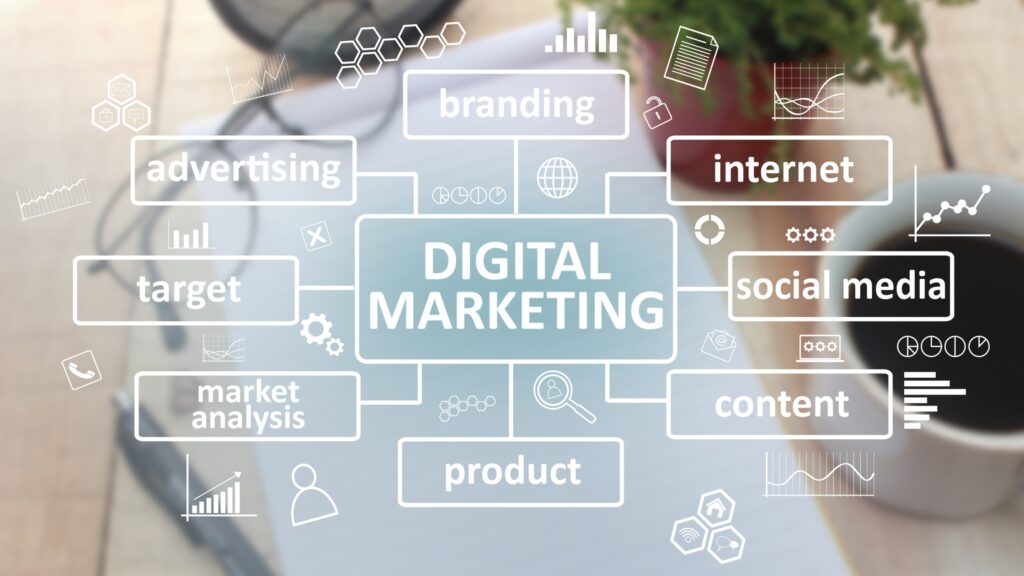Introduction
In today’s business landscape, digital marketing plays a pivotal role in reaching and engaging with target audiences. With the widespread use of the internet and social media platforms, businesses have unprecedented opportunities to connect with potential customers on a global scale. Digital marketing enables businesses to enhance their brand visibility, drive website traffic, generate leads, and ultimately increase sales and revenue.
The aim of this blog is to delve into the diverse array of digital marketing strategies available to businesses. From search engine optimization (SEO) to social media marketing, email campaigns to influencer partnerships, there’s a plethora of tactics and techniques for businesses to leverage in their digital marketing efforts. By exploring these different types of digital marketing strategies, readers can gain insights into which approaches align best with their goals and target audience, ultimately empowering them to develop more effective and comprehensive marketing strategies for their businesses.
Search Engine Optimization (SEO)
Search Engine Optimization, commonly referred to as SEO, is the practice of enhancing a website’s visibility and ranking on search engine results pages (SERPs) for specific keywords and phrases relevant to its content, products, or services, its count in main types of digital marketing

Definition of SEO:
SEO involves optimizing various aspects of a website, both on-page and off-page, to improve its organic (unpaid) search engine ranking.
It aims to make a website more visible to users who are actively searching for information, products, or services related to what the website offers.
Importance of SEO:
SEO is crucial for increasing a website’s organic traffic, which consists of users who find the website through unpaid search results.
By ranking higher in search engine results, a website gains more visibility and credibility, leading to increased traffic, leads, and conversions.
Effective SEO strategies help businesses attract relevant visitors who are more likely to convert into customers, thus driving growth and revenue.
Key Components of SEO:
On-Page Optimization: This includes optimizing elements within a website, such as meta tags, headings, content, and images, to make them more relevant and appealing to search engines and users.
Off-Page Optimization: This involves activities outside the website, such as link building, social media marketing, and online reputation management, to improve the website’s authority and credibility.
Technical SEO: This focuses on optimizing the technical aspects of a website, such as site speed, mobile-friendliness, and crawlability, to ensure it is accessible and user-friendly for both search engines and users.
Goals of SEO:
Increase Website Visibility: By improving search engine rankings, SEO aims to increase a website’s visibility and reach a larger audience.
Drive Organic Traffic: SEO helps attract targeted organic traffic from users actively searching for relevant information, products, or services.
Enhance User Experience: By optimizing website content and structure, SEO aims to provide a better user experience, leading to higher engagement and conversion rates.
Achieve Business Objectives: Ultimately, the goal of SEO is to support and achieve business objectives, such as increasing sales, generating leads, or building brand awareness.
Social Media Marketing types of digital marketing
Social Media Marketing (SMM) is a types digital marketing strategy that utilizes social media platforms to connect with target audiences, build brand awareness, and foster engagement.

Overview of social media marketing and its role in brand awareness and engagement:
Define social media marketing as the use of social media platforms to promote products, services, or content and engage with audiences.
Explain its significance in today’s digital landscape, where billions of people worldwide actively use social media platforms for communication, entertainment, and information.
Highlight the role of social media marketing in increasing brand visibility, reaching target demographics, and fostering meaningful interactions with customers and followers.
Discussion of different social media platforms and their unique advantages:
Provide an overview of popular social media platforms such as Facebook, Instagram, Twitter, LinkedIn, YouTube, and TikTok.
Discuss each platform’s unique features, target demographics, and advantages for businesses:
Facebook: Largest user base, diverse audience demographics, robust advertising options.
Instagram: Visual-focused platform, ideal for showcasing products and lifestyle content, high engagement rates.
Twitter: Real-time communication, news dissemination, customer service interactions.
LinkedIn: Professional networking, B2B marketing, thought leadership.
YouTube: Video-sharing platform, second-largest search engine, ideal for tutorials, product demos, and storytelling.
TikTok: Short-form video content, entertainment-focused, Gen Z audience.
Emphasize the importance of understanding the audience demographics and behavior on each platform to tailor social media marketing strategies effectively.
Case studies highlighting effective social media marketing strategies:
Provide real-world examples of businesses or brands that have successfully leveraged social media marketing to achieve their objectives.
Describe the strategies and tactics used in these case studies, such as:
Content creation: Creating engaging and relevant content tailored to each platform and audience.
Audience engagement: Responding to comments, messages, and mentions promptly to foster a sense of community and build brand loyalty.
Influencer partnerships: Collaborating with influencers or brand ambassadors to amplify reach and credibility.
Paid advertising: Utilizing targeted ads to reach specific demographics, drive website traffic, or promote products/services.
Highlight the measurable results and impact of these social media marketing campaigns, such as increased brand awareness, website traffic, engagement metrics, and conversions.
Content Marketing and Its Objectives
Content marketing is a strategic marketing approach focused on creating and distributing valuable, relevant, and consistent content to attract and retain a clearly defined audience. content is called king in types of digital marketing Its primary objectives include:

Building Brand Awareness: Content marketing helps businesses increase brand visibility by creating valuable content that educates, entertains, or inspires their target audience. Through consistent content creation and distribution, businesses can establish themselves as authorities in their industry and attract new audiences.
Generating Leads and Nurturing Relationships: IN types of digital marketing Content marketing aims to attract potential customers by providing valuable information that addresses their needs and challenges. By offering helpful content, businesses can capture leads and nurture relationships with prospects over time, eventually converting them into customers.
Driving Engagement and Interactions: Content marketing encourages audience engagement and interactions through likes, shares, comments, and other forms of social interaction. Engaging content fosters a sense of community around a brand, strengthens customer relationships, and encourages brand advocacy.
Increasing Website Traffic: High-quality content optimized for search engines can help businesses improve their website’s visibility and attract organic traffic. By consistently publishing valuable content that addresses relevant topics and keywords, businesses can increase their website traffic and reach more potential customers.
Exploration of Various Content Marketing Tactics
Content marketing encompasses a wide range of tactics and formats, including:
Blogging: Publishing articles, guides, tutorials, and other written content on a blog to educate, inform, and entertain the target audience. Blogging allows businesses to demonstrate their expertise, attract organic traffic from search engines, and engage with their audience on a regular basis.
Video Marketing: Creating and sharing videos on platforms like YouTube, Vimeo, and social media to convey information, demonstrate products, tell stories, and engage the audience visually. Video marketing is highly effective in capturing attention, conveying complex concepts, and building emotional connections with the audience.
Infographics: Visual representations of information, data, or knowledge designed to make complex ideas easier to understand and digest. Infographics combine text, visuals, and design elements to convey information quickly and clearly, making them highly shareable and engaging for audiences.
Examples of Brands Excelling in Content Marketing and Driving Conversions
Several brands have successfully leveraged content marketing to achieve their business goals and drive conversions:
HubSpot: HubSpot is a leading provider of inbound marketing and sales software. Through its blog, ebooks, webinars, and other content resources, HubSpot educates and empowers its audience with valuable information about marketing, sales, and business growth strategies.
GoPro: GoPro, a manufacturer of action cameras, excels in content marketing by leveraging user-generated content (UGC) to showcase the capabilities of its products. GoPro encourages customers to share their adventures and experiences captured with GoPro cameras, creating a vibrant community of brand advocates and inspiring others to purchase GoPro products.
Red Bull: Red Bull is renowned for its content marketing efforts, particularly in the realm of extreme sports and adventure. Through its Red Bull Media House, the company produces high-quality video content, documentaries, and live events that celebrate adrenaline-fueled activities and appeal to its target audience of young, adventurous consumers.
These examples demonstrate how effective content marketing strategies can drive engagement, build brand loyalty, and ultimately lead to conversions for businesses across various industries. By consistently creating valuable, relevant, and engaging content, brands can attract and retain customers, increase brand awareness, and achieve their business objectives.
Email Marketing
Email marketing is a best types of digital marketing strategy that involves sending commercial messages to a group of people via email. It is a highly effective method for nurturing leads and retaining customers due to its personalized and targeted nature.

Introduction to Email Marketing:
Email marketing allows businesses to communicate directly with their audience, delivering relevant content, promotions, and updates directly to their inbox. It is a cost-effective and efficient way to build relationships with leads and customers, drive sales, and increase brand loyalty.
Types of Email Marketing Campaigns:
Newsletters: Regularly scheduled emails that provide subscribers with updates, news, and valuable content related to the business or industry. Newsletters help businesses stay top-of-mind with their audience and provide opportunities to share useful information and promotions.
Promotional Emails: Emails specifically designed to promote products, services, or special offers to subscribers. Promotional emails can include discounts, sales announcements, new product launches, or event invitations. They aim to drive immediate action and conversions from recipients.
Drip Campaigns: Automated email sequences that are sent over a period of time to nurture leads and guide them through the customer journey. Drip campaigns are often triggered by specific actions or milestones, such as signing up for a newsletter, downloading a lead magnet, or abandoning a cart. They deliver targeted content and offers to move recipients closer to making a purchase.
Tips for Crafting Compelling Email Content and Optimizing Email Deliverability:
Personalization: Personalize email content by addressing recipients by name and segmenting your email list based on demographics, interests, or past interactions. Tailor content and offers to match the preferences and needs of different segments of your audience.
Engaging Subject Lines: Use concise, attention-grabbing subject lines that compel recipients to open the email. Avoid spammy or misleading subject lines and focus on providing value or piquing curiosity.
Clear Call-to-Action (CTA): Include a clear and compelling call-to-action (CTA) in every email to prompt recipients to take the desired action, whether it’s making a purchase, signing up for an event, or visiting a website.
Mobile Optimization: Ensure that your emails are optimized for mobile devices, as a significant portion of email opens occur on smartphones and tablets. Use responsive design and test your emails across different devices and email clients to ensure they display properly.
Monitor and Analyze Performance: Track key metrics such as open rates, click-through rates, and conversion rates to measure the effectiveness of your email campaigns. Use this data to refine your strategies, test different approaches, and optimize future campaigns for better results.
By following these best practices, businesses can create compelling email campaigns that effectively nurture leads, retain customers, and drive engagement and conversions. Additionally, focusing on email deliverability ensures that your messages reach recipients’ inboxes and avoid being flagged as spam, maximizing the impact of your email marketing efforts.
Pay-Per-Click (PPC) Advertising
PPC meant Paid types of digital marketing
Explanation of PPC advertising and its role in driving targeted traffic and conversions:

Define PPC advertising as a digital advertising model where advertisers pay a fee each time their ad is clicked.
PPC advertising allows businesses to bid for ad placement in search engine results or on websites and social media platforms.
Highlight its role in driving targeted traffic and conversions by enabling businesses to reach specific audiences based on demographics, interests, keywords, and behavior.
Overview of different PPC platforms (Google Ads, Facebook Ads, etc.) and their features:
Overview of different PPC platforms (Google Ads, Facebook Ads, etc.) and their features:
Google Ads:
Describe Google Ads as a PPC advertising platform that displays ads in Google’s search engine results and across its network of partner websites.
Highlight features such as keyword targeting, ad extensions, remarketing, and audience targeting options.
Facebook Ads:
Explain that Facebook Ads allows businesses to create and target ads to users on Facebook and Instagram based on demographics, interests, behaviors, and connections.
Discuss features such as custom audience targeting, lookalike audience targeting, ad formats (carousel, slideshow, video, etc.), and placement options.
Other PPC Platforms:
Briefly mention other PPC advertising platforms such as LinkedIn Ads, Twitter Ads, Microsoft Advertising (formerly Bing Ads), and Amazon Advertising.
Highlight their unique features, target audiences, and ad formats.
Strategies for optimizing PPC campaigns and maximizing ROI:
Keyword Research and Selection:
Emphasize the importance of thorough keyword research to identify relevant keywords with high search volume and low competition.
Discuss strategies for selecting targeted keywords, including long-tail keywords, negative keywords, and competitor analysis.
Ad Copy and Creative:
Provide tips for crafting compelling ad copy and creative that grabs attention, highlights unique selling points, and includes a clear call-to-action (CTA).
Recommend testing different ad variations to identify the most effective messaging and imagery.
Targeting and Audience Segmentation:
Discuss the importance of targeting specific audiences based on demographics, interests, behaviors, and intent.
Explain how to create segmented campaigns and ad groups to tailor messaging and offers to different audience segments.
Monitoring and Optimization:
Stress the importance of ongoing monitoring and optimization of PPC campaigns to improve performance and maximize ROI.
Recommend analyzing key metrics such as click-through rate (CTR), conversion rate, cost per acquisition (CPA), and return on ad spend (ROAS).
Discuss optimization techniques such as bid adjustments, ad scheduling, ad testing, and campaign budget allocation.
Conversion Tracking and Attribution:
Explain the significance of setting up conversion tracking to measure the effectiveness of PPC campaigns in driving conversions.
Discuss attribution models and the importance of understanding the customer journey across multiple touchpoints to optimize campaigns for maximum impact.
By implementing these strategies, businesses can optimize their PPC campaigns across various platforms to drive targeted traffic, increase conversions, and maximize return on investment (ROI).
Influencer Marketing
Define influencer marketing as a types of digital marketing that involves collaborating with individuals who have a significant online following and influence over their audience.
Explain that influencer marketing focuses on leveraging the credibility and trust that influencers have built with their followers to promote products, services, or brands.
Discuss its impact on consumer behavior, highlighting how recommendations from trusted influencers can sway purchasing decisions, build brand awareness, and foster brand loyalty among their followers.

Steps for identifying and partnering with influencers relevant to your niche:
Define Your Goals and Target Audience:
Determine the objectives of your influencer marketing campaign, whether it’s increasing brand awareness, driving sales, or reaching a specific demographic.
Identify your target audience and the types of influencers they follow, considering factors such as interests, demographics, and online behavior.
Research and Identify Potential Influencers:
Conduct thorough research to identify influencers who align with your brand values, target audience, and campaign objectives.
Use influencer marketing platforms, social media listening tools, and manual searches on platforms like Instagram, YouTube, and TikTok to find relevant influencers.
Evaluate Influencer Credibility and Reach:
Assess influencers based on criteria such as the size and engagement of their audience, relevance to your niche, content quality, and authenticity.
Look for influencers who have a genuine connection with their audience, demonstrate expertise in your industry, and align with your brand values.
Reach Out and Establish Relationships:
Personalize your outreach to influencers, expressing genuine interest in their content and audience.
Propose collaboration opportunities that are mutually beneficial and aligned with their interests and audience preferences.
Negotiate Terms and Agreements:
Discuss campaign details, deliverables, compensation, and expectations with influencers transparently.
Draft and finalize agreements outlining the scope of work, timelines, payment terms, and any exclusivity or usage rights.
Examples of successful influencer marketing collaborations:
Daniel Wellington x Influencers:
Daniel Wellington, a watch brand, collaborated with fashion influencers on Instagram to promote their products.
Influencers shared curated lifestyle photos featuring Daniel Wellington watches, often accompanied by discount codes or affiliate links.
The campaign helped Daniel Wellington increase brand awareness, drive sales, and establish itself as a trendy and aspirational brand among millennials and Gen Z consumers.
Gymshark x Fitness Influencers:
Gymshark, a fitness apparel brand, partnered with fitness influencers and athletes to promote its activewear products.
Influencers created workout videos, sponsored posts, and product reviews showcasing Gymshark apparel in action.
The campaign helped Gymshark reach a broader audience of fitness enthusiasts, drive website traffic, and generate buzz around new product launches.
These examples illustrate how strategic influencer marketing collaborations can help brands reach and engage with their target audience authentically, drive brand awareness, and ultimately, achieve their marketing goals.
Conclusion
In conclusion, the diverse landscape these types of digital marketing offers businesses a multitude of avenues to reach and engage with their target audience in today’s highly competitive online environment. From search engine optimization (SEO) to social media marketing, content marketing, email marketing, pay-per-click (PPC) advertising, influencer marketing, and more, each type of digital marketing serves a unique purpose and provides distinct opportunities for businesses to connect with consumers.
As types of digital marketing continues to evolve and adapt to changing consumer behaviors and technological advancements, businesses must remain agile and strategic in their approach. By staying informed about emerging trends, embracing experimentation, and prioritizing customer-centricity, businesses can stay ahead of the curve and capitalize on the vast potential of digital marketing to propel their growth and success in the digital age.
FAQ’s
What are the latest digital marketing trends?
Some of the latest types of digital marketing trends for 2024 include the rise of video content, the increasing importance of personalization in marketing strategies, the growing influence of micro-influencers, the adoption of AI-driven marketing automation, and the focus on user-generated content to enhance authenticity and engagement.
How can businesses leverage artificial intelligence (AI) in their marketing strategies?
Businesses can leverage AI in their marketing strategies by utilizing AI-powered tools for data analysis, customer segmentation, predictive analytics, chatbots for customer service, personalized content recommendations, and dynamic pricing optimization. AI enables businesses to automate processes, improve targeting accuracy, and enhance the overall customer experience.
What are the key factors to consider when optimizing websites for voice search?
Key factors to consider when optimizing websites for voice search include focusing on conversational and natural language keywords, optimizing for featured snippets and local SEO, ensuring fast loading times and mobile-friendliness, and providing clear and concise answers to common user queries.
How does user-generated content (UGC) impact brand engagement and loyalty?
User-generated content (UGC) can significantly impact brand engagement and loyalty by fostering authenticity, building trust, and creating a sense of community among customers. UGC showcases real experiences and testimonials from satisfied customers, which can influence purchasing decisions and strengthen brand advocacy.
What are the best practices for creating viral social media content?
Some best practices for creating viral social media content include understanding your target audience, leveraging trending topics and hashtags, creating visually appealing and shareable content, incorporating storytelling elements, encouraging user participation and engagement, and optimizing posting times and frequency.
How can businesses effectively measure the ROI of their influencer marketing campaigns?
Businesses can effectively measure the ROI of their influencer marketing campaigns by setting clear campaign objectives and KPIs, tracking engagement metrics such as likes, shares, comments, and clicks, monitoring referral traffic and conversion rates, and calculating the overall return on investment based on campaign costs and generated revenue.
How does personalization impact customer experience and conversion rates in digital marketing?
Personalization impacts customer experience and conversion rates in types of digital marketing by tailoring content, offers, and recommendations to individual user preferences and behaviors. Personalized marketing efforts make customers feel valued and understood, leading to increased engagement, loyalty, and ultimately, higher conversion rates.

